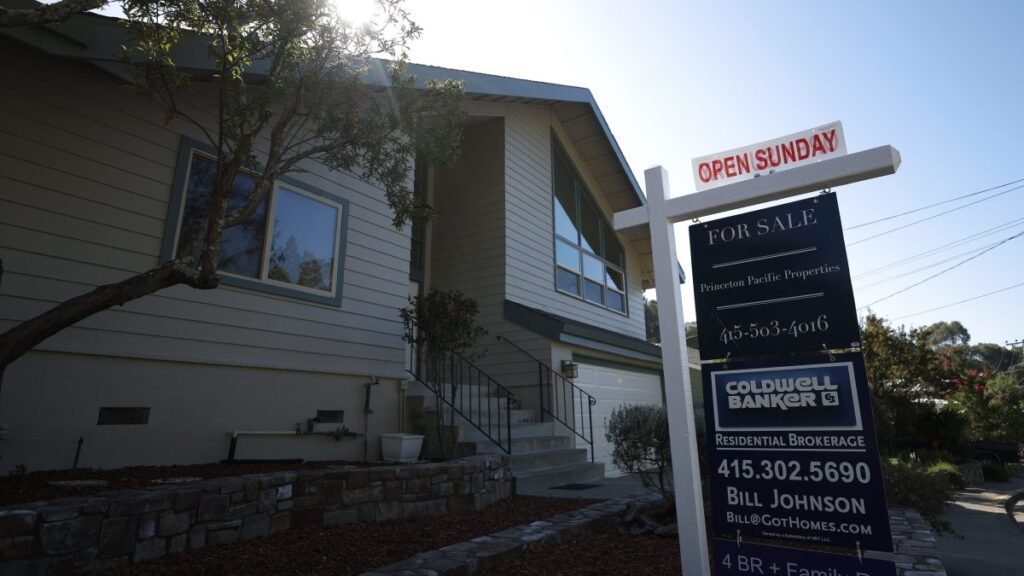For the past year, the interest rate set by the Federal Reserve — the federal funds rate — has stayed the same. At the same time, average rates for a 30-year fixed interest mortgage have bounced around from as high as nearly 7.8% last fall to as low as 6.6% in February, according to Freddie Mac.
So if the Fed’s rate is unchanged, why do mortgage rates keep moving around? The answer matters to borrowers hoping for mortgage rates to fall soon.
That includes Nicole Wildart. About a year and a half ago, she bought a house in Maryland, with a mortgage rate well above 6%. She said she knew that was going to be tough to afford in the long term, but she figured she would refinance as soon as it made sense. So she’s been watching mortgage rates ever since.
“I usually search for like, ‘When are they going to lower? Please tell me when the rates are going to lower?’” she said.
The results from those searches have not been satisfying. Mortgage rates are still higher than what she’s looking for, and she’s getting frustrated.
“I know, the Fed sets the rates, and then the interest rates for home mortgages are based on some relationship to that,” Wildart said.
That’s a good starting point — but there’s more to mortgages than the Fed’s interest rate.
Think of a mortgage like a layer cake. The federal funds rate is the first layer; that’s the rate many observers expect the Fed to cut in September. It’s essentially the amount it costs banks to lend money to each other.
“The Fed funds rate is their cost of doing business,” said Nancy Wallace, a professor at the University of California Berkeley’s Haas School of Business.
A bank will want to make up for that cost when it offers you a mortgage, so your rate will likely be higher than the federal funds rate.
Then, there’s a layer that accounts for inflation, Wallace said.
“For people to be willing to hold a 30-year mortgage, where they expect tomorrow’s dollar to be worth less than today’s dollar, they’re going to price that into the interest rate that they’re going to be willing to offer that mortgage for,” she said.
So, you’ve got the lender’s cost of doing business, then inflation expectations. Those are topped with another layer of that cake, which is where things get more complicated. Because after a lender gives you a mortgage, they usually don’t hold onto it.
“They end up selling it to investors, who then package these mortgages, and they just become another financial instrument,” said Selma Hepp, chief economist at CoreLogic.
Those packages are known as mortgage-backed securities. Other investors then buy up these securities.
“The more investors that you have, they’re competing for that product, and so the price of the product goes down,” Hepp said.
It’s in this layer — the market for mortgage-backed securities — where mortgage rates are really determined. Investor demand and competition with other investments drive rates up and down, according to Andy Walden, vice president of research and analysis at Intercontinental Exchange.
“It’s folks that are investing in those mortgage-backed securities and what interest rate they’re really requiring to invest in those securities,” he said. “How much risk do they see? And how much risk-free return could they get elsewhere?”
Investors are specifically weighing the return they could get from one of the safest investments around: U.S. government bonds — 10-year treasury bonds in particular.
Those bonds are considered safe because, “I know the government’s going to pay me back,” Walden said. “That’s a risk-free loan that I’m giving them.”
Mortgage-backed securities, by comparison, are famously not as safe.
“It’s a little bit riskier to lend to an end consumer where they may not be able to perform on that debt,” Walden said. “They may default.”
Or a borrower could refinance, meaning the investor won’t get all the interest. Those risks push mortgage-backed securities — and therefore mortgage rates — above 10-year treasury yields.
But the two track pretty closely together. Lately, treasury yields have been heading lower because investors are buying more of them as they move money away from riskier investments. And that could push mortgage rates down further, unleashing a lot of pent-up activity in the housing market.
“If mortgage rates drop, you’re going to see a surge in home buying and home selling, as well as probably mortgage refinancing,” said Guy Cecala, head of the research firm Inside Mortgage Finance.
In Maryland, Nicole Wildart hopes to be part of that refinancing surge.
“If I could even just get it to 6.0%, that would be a huge win for our monthly finances,” she said.
For now, she’ll keep watching rates — hoping they come down.
There’s a lot happening in the world. Through it all, Marketplace is here for you.
You rely on Marketplace to break down the world’s events and tell you how it affects you in a fact-based, approachable way. We rely on your financial support to keep making that possible.
Your donation today powers the independent journalism that you rely on. For just $5/month, you can help sustain Marketplace so we can keep reporting on the things that matter to you.

